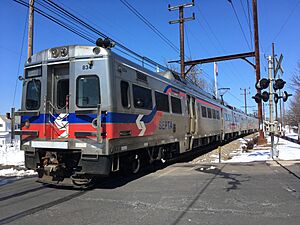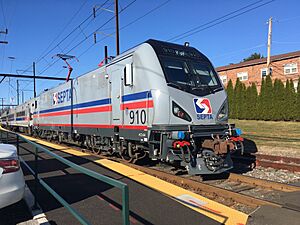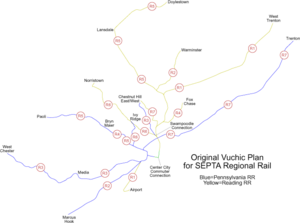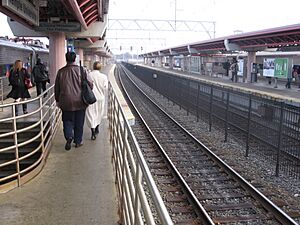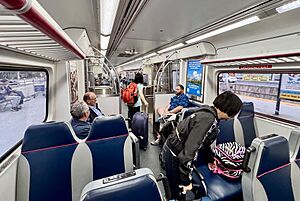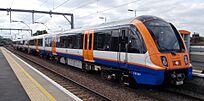SEPTA Regional Rail facts for kids
Quick facts for kids SEPTA Regional Rail |
|||
|---|---|---|---|
 Silverliner V SEPTA-811-philadelphia-22-6-2012-fws.jpg |
|||
| Info | |||
| Owner | SEPTA | ||
| Transit type | Commuter rail | ||
| Number of lines | 13 | ||
| Number of stations | 155 | ||
| Headquarters | 1234 Market Street Philadelphia, Pennsylvania 19107 |
||
| Operation | |||
| Began operation | Assumed operations in 1976, officially established 1983 | ||
| Reporting marks | SEPA, SPAX | ||
| Number of vehicles | 404 revenue vehicles as of 2015[update] | ||
| Technical | |||
| System length | Total: 280 mi (450 km)
|
||
| Track gauge | 4 ft 8 1⁄2 in (1,435 mm) standard gauge | ||
| Electrification | Overhead line, 12 kV 25 Hz AC: Amtrak's 25 Hz traction power system SEPTA's 25 Hz traction power system |
||
|
|||
The SEPTA Regional Rail system is a network of trains that helps people travel around the Philadelphia area. It's like a big bus system, but with trains! These trains are owned by SEPTA, which stands for Southeastern Pennsylvania Transportation Authority.
The system has 13 different train lines and more than 150 stations. These stations are located in Philadelphia, its nearby towns, and other cities. It's one of the busiest commuter train systems in the United States. In 2016, about 132,000 people rode these trains every day.
The main part of the Regional Rail system is the Center City Commuter Connection. This is a special tunnel that connects three important stations in downtown Philadelphia. These stations are 30th Street Station, Suburban Station, and Jefferson Station. Almost all trains stop at these three stations. Many also stop at Temple University station.
Contents
Train Lines and Routes
The 13 train lines used to have "R-numbers" like R1 or R2. This system was changed in 2010 because it was confusing. Now, each line is named after the main towns or areas it connects.
Former Pennsylvania Railroad Lines
These lines were originally part of the Pennsylvania Railroad (PRR).
- Airport Line: This line goes directly to the Philadelphia International Airport. It started running in 1985.
- Chestnut Hill West Line: This line ends in the Chestnut Hill part of Philadelphia.
- Cynwyd Line: This line goes to Cynwyd and only runs on weekdays.
- Media/Wawa Line: This line goes to Wawa. Service to Wawa was brought back in 2022.
- Paoli/Thorndale Line: Trains on this line go to Malvern or Thorndale. Some trains also stop at Bryn Mawr or Paoli during busy times.
- Trenton Line: This line goes all the way to Trenton, New Jersey. You can connect to other trains here to go to New York City.
- Wilmington/Newark Line: This line goes to Wilmington, Delaware. Some weekday trains continue to Newark, Delaware.
Former Reading Company Lines
These lines were originally part of the Reading Company.
- Chestnut Hill East Line: This line also ends in the Chestnut Hill part of Philadelphia.
- Fox Chase Line: This line goes to the Fox Chase part of Philadelphia.
- Lansdale/Doylestown Line: This line goes to Doylestown. Many trains also stop at Lansdale.
- Manayunk/Norristown Line: This line goes to Norristown.
- Warminster Line: This line ends in Warminster.
- West Trenton Line: This line goes to the West Trenton station in Ewing, New Jersey.
Network Map
Train Stations
The Regional Rail system has 154 active stations. Most of these are in Philadelphia and its surrounding counties in Pennsylvania. Six stations are outside Pennsylvania, in New Jersey and Delaware.
In 2003, about 61% of all train trips started at a station in Philadelphia. The three main downtown stations and Temple University station were especially busy.
| County | Stations | Boardings in 2003 | Boardings in 2001 |
|---|---|---|---|
| Philadelphia | 51 | 60 967 | 61 970 |
| Montgomery County | 42 | 17 228 | 18 334 |
| Delaware County | 29 | 8 310 | 8 745 |
| Bucks County | 16 | 5 332 | 5 845 |
| Chester County | 10 | 5 154 | 5 079 |
| Outside Pennsylvania | 6 | 2 860 | 3 423 |
| total | 154 | 99 851 | 103 396 |
Train Cars and Locomotives
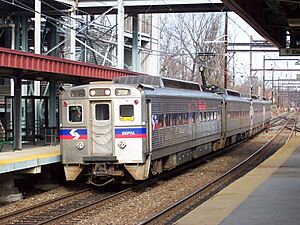
A SEPTA Silverliner IV train at Fern Rock Transportation Center in Philadelphia
|
SEPTA uses different types of trains. Many are called "Silverliner" cars. These are electric trains that can run by themselves. SEPTA also uses "push-pull" trains. These trains have a powerful electric engine called an ACS-64 locomotive at one end. It either pulls the train or pushes it from behind.
The Silverliner trains have been around for a long time. The first ones were built in 1958. Newer versions, like the Silverliner V, were introduced in 2010. These newer cars have wider seats and special doors for easier boarding.
In 2014, SEPTA started a plan to update its trains and tracks. New ACS-64 locomotives arrived in 2018. They also planned to get new multi-level train cars, but that order was cancelled in April 2024 due to problems.
Electric Trains (EMUs)
These trains are electric and can run as single cars or connected pairs.
| Year | Make | Model | Numbers | Type | Total | Seats | Notes |
|---|---|---|---|---|---|---|---|
| 1973–76 | GE | Silverliner IV | 101–188 | married pairs | 88 | 125 | |
| 304–399 | 95 | ||||||
| 417–460 | 44 | ||||||
| 276–303 | single cars | 28 | |||||
| 400–416 | 16 | ||||||
| 2010–13 | Rotem | Silverliner V | 701–738 | single cars | 38 | 110 | These cars replaced older ones and added more space. They were temporarily taken out of service in 2016 for repairs. |
| 801–882 | married pairs | 82 |
Push-Pull Passenger Cars
These are the cars pulled or pushed by a separate locomotive.
| Year | Make | Model | Type | Numbers | Total | Seats | Notes |
|---|---|---|---|---|---|---|---|
| 1987 | Bombardier | SEPTA I | Cab cars | 2401–2410 | 10 | 118 | |
| Trailers | 2501–2525 | 25 | 131 | ||||
| 1999 | SEPTA II | Trailers | 2550–2559 | 10 | 117 | These cars have a middle door for easy boarding at high platforms. |
Locomotives
These are the powerful engines that pull or push the trains.
| Year | Make | Model | Numbers | Total | Notes |
|---|---|---|---|---|---|
| 2018 | Siemens | ACS-64 | 901–915 | 15 | These started service on July 11, 2018. They replaced older locomotives. |
How the Trains Get Power
All SEPTA Regional Rail lines use electricity from overhead wires called "catenary." This electricity is 12,000 volts and 25 Hertz.
The system has two main parts: one owned by Amtrak (from the old Pennsylvania Railroad) and one owned by SEPTA (from the old Reading Company). These two systems are not connected electrically. When a train moves from one system to the other, it crosses a short section of track with no power. The train just coasts across this "phase break."
Train Yards and Repair Shops
SEPTA has five main places where trains are stored and fixed:
- Frazer Yard: Located in Frazer, Pennsylvania, this yard works on push-pull trains.
- Overbrook Maintenance Facility: Near Overbrook station, this facility fixes the electric multiple unit (EMU) trains.
- Powelton Yard: Right next to 30th Street Station.
- Roberts Yard: Next to Wayne Junction.
- Wayne Junction Electric Car Shop: Also at Wayne Junction (SEPTA station).
History of SEPTA Regional Rail
SEPTA was created to make sure that passenger train services didn't disappear. In the 1960s, fewer people were riding trains because more people had cars. Train companies were losing money. SEPTA stepped in to help by giving money to these companies to keep the trains running.
Early Railroads and Electrification
The Pennsylvania Railroad (PRR) and the Reading Company used to run both passenger and freight trains. They started using electricity for their busiest passenger lines in 1915. This made the trains more efficient. They used overhead wires with 11,000 volts of electricity.
The PRR electrified its lines starting in 1915. The Reading Company started electrifying its lines in 1931. This meant electric trains replaced older trains pulled by steam engines.
By the late 1950s, running passenger trains became very expensive for these companies. More people were driving cars, and new highways were being built. This meant fewer people were taking the train. The railroads started to neglect their equipment, making train rides less pleasant.
To help, the city of Philadelphia started a program in 1958 to pay the railroads to keep commuter service going. This program grew, and in 1966, SEPTA began making contracts with the PRR and Reading Company to support their train lines.
However, these payments weren't enough to save the big railroad companies. The PRR merged with another company but went bankrupt in 1970. The Reading Company also went bankrupt in 1971. In 1976, a new company called Conrail took over the train operations. Conrail ran the trains for SEPTA until January 1, 1983, when SEPTA took over completely.
The Center City Tunnel
For a long time, trains from the Pennsylvania Railroad and Reading Company ended at different stations in downtown Philadelphia. This made it hard for people to switch between lines. In 1960, the idea of building a tunnel to connect these lines was proposed.
The tunnel, called the Center City Commuter Connection, was built between 1976 and 1984. It cost $330 million. When it opened in November 1984, it connected the two separate train systems. Now, trains could travel straight through downtown, making it easier for passengers and reducing traffic at the stations.
The original plan for how the trains would run was designed by a professor named Vukan Vuchic. He based it on similar train systems in Germany. The idea was to have trains from one side of the system continue onto a line from the other side. This would reduce the need for passengers to transfer.
Changes and Challenges in the 1980s
The 1980s were a tough time for SEPTA. There were strikes, not enough train engineers, and service cuts. Many people thought SEPTA was not managed well.
Despite these challenges, there were some improvements. The Airport Line opened in April 1985, connecting downtown Philadelphia to the airport. In 2022, service was brought back to Wawa Station on the Media/Wawa Line. This project included new tracks, signals, and a new station with a large parking area.
However, some services were cut. For example, some diesel train lines were stopped in the early 1980s. Also, parts of the Media/Wawa Line and Cynwyd Line were shortened in 1986 due to track problems.
RailWorks Project
In 1992, a bridge near Temple University Station was found to be unsafe. This caused major problems for train service. SEPTA started a big project called "RailWorks" to fix the bridge and other parts of the tracks.
From April to October 1992, and again from May to September 1993, parts of the train system were shut down. During this time, SEPTA replaced old bridges, installed new tracks and overhead wires, and built new stations at Temple University and North Broad Street. When RailWorks was finished, the Reading Viaduct became a much newer and safer part of the train system.
How Many People Ride the Trains
When Conrail ran the trains, ridership was highest in 1980, with over 32 million passengers. After SEPTA took over in 1983, ridership dropped sharply. This was because of a long strike by train workers, fewer stations, higher fares, and SEPTA being new to running a commuter railroad.
Ridership dropped again in 1992 due to economic reasons and the RailWorks project. But by the late 1990s, ridership started to grow again. In 2008, it reached a new high of over 35 million passengers. By 2015, it hit a record of 37.7 million trips.
The chart below shows how many people rode SEPTA Regional Rail trains each year from 1979 to 2021.
2014 Strike
On June 14, 2014, SEPTA Regional Rail service stopped because of a strike by train workers. The Governor asked the President to help end the dispute. President Obama signed an order that made the workers go back to work. Service started again on June 15.
COVID-19 Changes (2020-2021)
During the COVID-19 pandemic, SEPTA Regional Rail ran a special "Lifeline Service." Some lines were temporarily stopped or shortened in April and May 2020. Over time, service slowly returned to all lines. By December 2021, weekend service was back on the Chestnut Hill West Line.
Future Plans: Philadelphia Transit Plan 2045
In February 2021, Philadelphia announced a plan for its public transportation system through 2045. For Regional Rail, this plan includes making trains run more often and changing how fares work. It also suggests creating "metro-like" Regional Rail lines, which would be similar to subway lines.
This plan would divide Regional Rail into three types of service:
- The Silver Line: This would be a new line running from Fern Rock Transportation Center to Penn Medicine Station. It would have trains every 15 minutes, like a bus line, and fares would be similar to other SEPTA transportation.
- Frequent Regional Rail: These lines would be like the Silver Line, with lower fares, free transfers, and trains running more often. The plan suggests converting parts of the Manayunk/Norristown, Chestnut Hill East, and Airport lines to this style.
- Regional Express Service: These lines would be more like the current Regional Rail, making fewer stops closer to Philadelphia.
This big plan would require many years and a lot of money to complete. It also suggests extending train service to places like Phoenixville, Quakertown, and West Chester.
Images for kids
See also
 In Spanish: Ferrocarril Regional SEPTA para niños
In Spanish: Ferrocarril Regional SEPTA para niños
- Commuter rail in North America
- List of Pennsylvania railroads
- List of suburban and commuter rail systems
- List of North American commuter rail operators
- List of United States commuter rail systems by ridership



